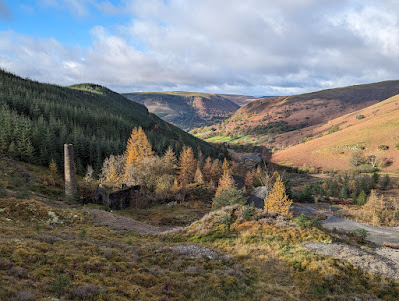A visit into the past: Day 3 - Caio and Rhandirmwyn
From Caio to Utah
Sarah Williams, my third great grandmother whose gravestone we found in Llansawel, had a younger sister, Mary. In 1820, Mary married Joseph Lewis, from the nearby village of Caio. We passed through this village on the first afternoon of this trip and visited the churchyard where Joseph was buried (but we didn't find any gravestone).
However, some of their children - whose descendants match DNA with mine - weren’t buried anywhere in Wales. Instead, they emigrated to the United States, two of them in Utah as Mormon Pioneers. The "History of Llansawel" describes how Mormon missionaries had visited the area and had "created quite a stir by their preaching and teaching".
The burial records for both Mary and Joseph give their last abode as "Tyn y Lan, Llanwrda", which also matches the 1851 census record where Joseph is listed there as a "farmer of 38 acres". Having found that smallholding marked on an old map of the area, we drove down a narrow lane south of the hamlet of Porthyrhyd to find it. And we did!
Isolated amongst woods and fields, the farm buildings could still be found there, modernised but retaining the same name from those old family roots.
The lead miners of Rhandirmwyn
From Tyn y Lan, we drove up the Towy valley to another village that features in the 'Williams' part of my ancestry, the lead miners' village of Rhandirmwyn. The first thing we noticed driving into the village was that it was on a hillside surrounded by trees, not scarred by mine workings.
The lead mine itself was in the valley behind the forested ridge. It had employed about 400 people at the height of its profitability.
We walked up through the trees above the village to come out on the track above the old mine workings:
We walked down through the remains of the site, then back to Rhandirmwyn.
How exactly does this mine link with my family history? Well, in 1843, Mary, the eldest daughter of Charles and Sarah Williams from Llansawel, married a Rhandirmwyn miner named John Renowden. He had come to Wales from Cornwall to find work in the lead mine. As we had hoped, we found their gravestone in the churchyard of the village church of St. Barnabas.
We walked up the hill to the Royal Oak pub, where John Renowden was listed as the publican from 1851 to 1881 - and the gravestone records John and Mary as being from here too.
We walked further up the hill to Pannau Terrace - a surviving row of miners' cottages where John and Mary lived in the 1840s.
Their son, also John Renowden, was born here in 1846 and is listed, again as a lead miner or dresser, living at No.8 in the census records from 1881 to 1911. This is the cottage at the far end of the terrace, now painted pink:
One of the present occupants of another of the cottages told us that No.8 had also once operated as a pub, the Red Lion. Best of all, he showed us a book with an old photograph of John Renowden ('junior') himself!
Another of the Williams daughters, Sarah, also married another Rhandirmwyn miner, Morgan Williams, in 1852. Their marriage certificate gives Morgan's abode as being the same Pannau Place but Sarah's as Blaen y Waun, situated by the riverside, according to an old map. A new wooden farm shed now seems to occupy the site:
We also located other places around the village where census records show Morgan and Sarah had once lived, including the school on the main road entering the village from the north and another cottage, Porthudon, on the other entrance to the village.
Once again, the cottage had retained its old name:
Sarah was also not buried in Wales but America. After Morgan's death in 1877, like some other local mining families, she emigrated to live with most of her children in Pennsylvania, where skilled miners were needed. We didn't locate Morgan's gravestone at St.Barnabas so drove north to the Chapel of St. Paulinus at Ystradffin, with its ancient yew tree, to look at the gravestones there.
Most of these stones were written in Welsh, and a number of "Williams" names were amongst them. However, any links with Morgan and his family are going to need more investigation.
Finally, we drove further up the road to the Llyn Brianne reservoir where the waters of the Towy were tumbling over the dam that was built there in the 1960s.
Actually, that wasn't quite finally ... because we then drove to Llanddeusant, a small village under the Black Mountain, and walked up to Llyn y Fan Fach - but that's part of tomorrow's ancestry tales ...































Comments
Post a Comment